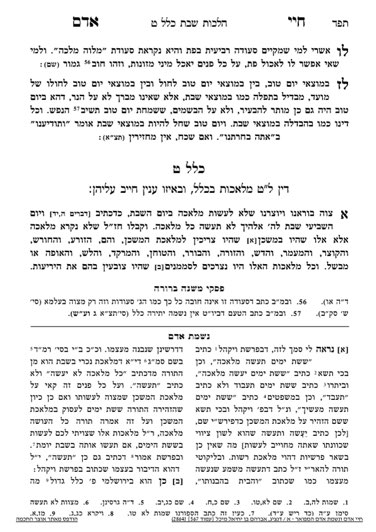We are continuing in siman 1, where the Chayei Adam delineates the 39 melachos. The next 13 melachos are related to the process of making the yerios (curtains) and bigdei kehuna:
- Gozeiz, shearing the wool from the sheep. We will discuss whether the melacha is defined by obtaining the hair for use, or by the act of removing it from the animal.
- Melabein, literally bleaching the wool for use. It includes any form of cleaning a garment for use.
- Menapeitz, combing the wool for any impurities and straightening it out. It is not such a common melacha nowadays.
- Tzoveah, dyeing the wool. The Chayei Adam will pasken later that the concept of dyeing does not apply to food, but otherwise, foods such as using a tea bag, tea essence, or pouring red wine into white wine would be assur.
- Toveh, spinning the fibers of wool into thread.
- Meisach is the process of preparing the shesi threads to be placed on the loom;
- Oseh shtei(2)batei nirim is there act of setting up the loom to enable raising and lowering shesi threads to allow for weaving;(It is not clear why the Chayei Adam gives the amount in this melacha (2) over any of the other melachos);
- Oreg is the act of weaving.
- Potzeiah is the act of undoing the weave if it needs to be fixed.
- Koshair is tying, and
- Matir is untying. The Bavli actually states that these two melachos were not part of the process of creating the yerios or bigdei kehuna. The Chayei Adam (in Nishmas Adam) discusses where else they are found in the mishkan. Although the Bavli gives a different place where they came up in the Mishkan, the Yerushalmi states they were part of the process of creating the yerios or bigdei kehuna.
- Tofair shtei tefiros, sewing together the various curtains. If one wishes to sew two garments together, placing the needle through the garments once does not create a stitch. The stitch is only created when the needle is sewn through the garments a second time. But even one stitch is not chayav, because one stitch does not last, and one of the conditions for a melacha to be chayav is that it lasts.
- Koreiah al menas litfor shtei tefiros, tearing out the stitches for the purpose of re-sewing. The Chayei Adam specifies that the purpose of tearing must be to re-sew it, because if it is just to tear, it is mekalkeil, a destructive act, and is patur deoraysa.
- Zoreah, Planting;
- Choreish, Preparing the ground for planting;
- Kotzair, Detaching something from its source of growth;
- Ma’ameir, Gathering harvested items;
- Dosh, Threshing and squeezing;
- Zoreh, Winnowing;
- Borer, Sorting a mixture by hand;
- Tochein, Grinding and dicing;
- Merakeid, Sorting with a utensil;
- Losh, Adding items together to create a mass;
- Bishul or ofeh, Cooking or baking.
- Gozeiz, shearing;
- Melabein, cleaning;
- Menapeitz, combing wool;
- Tzoveah, dyeing;
- Toveh, spinning fibers into thread;
- Meisach, setting up shesi threads;
- Oseh shtei batei nirim, preparing to interweave shesi and areiv;
- Oreg, weaving the shesi and areiv together;
- Potzeiah, undoing the weave to fix it;
- Koshair, tying;
- Matir, untying;
- Tofair, stitching;
- Koreiah al menas litfor shtei tefiros, tearing to re-sew



